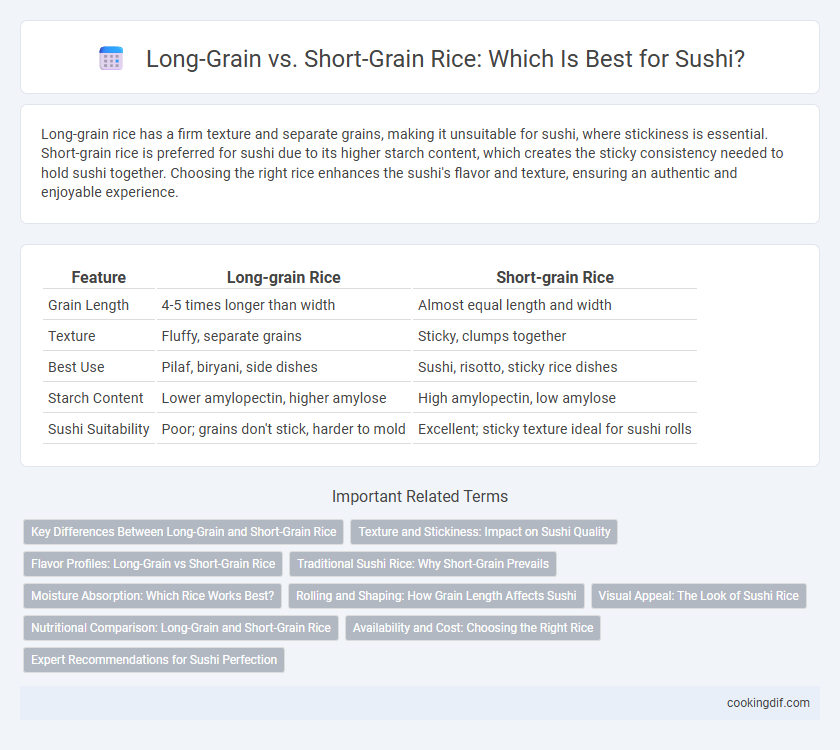Long-grain rice has a firm texture and separate grains, making it unsuitable for sushi, where stickiness is essential. Short-grain rice is preferred for sushi due to its higher starch content, which creates the sticky consistency needed to hold sushi together. Choosing the right rice enhances the sushi's flavor and texture, ensuring an authentic and enjoyable experience.
Table of Comparison
| Feature | Long-grain Rice | Short-grain Rice |
|---|---|---|
| Grain Length | 4-5 times longer than width | Almost equal length and width |
| Texture | Fluffy, separate grains | Sticky, clumps together |
| Best Use | Pilaf, biryani, side dishes | Sushi, risotto, sticky rice dishes |
| Starch Content | Lower amylopectin, higher amylose | High amylopectin, low amylose |
| Sushi Suitability | Poor; grains don't stick, harder to mold | Excellent; sticky texture ideal for sushi rolls |
Key Differences Between Long-Grain and Short-Grain Rice
Long-grain rice has a firm, dry texture and remains separate when cooked, making it unsuitable for sushi which requires stickiness. Short-grain rice contains higher amylopectin, resulting in a soft, sticky texture essential for holding sushi ingredients together. The key differences lie in starch content and moisture absorption, directly influencing texture and suitability for sushi preparation.
Texture and Stickiness: Impact on Sushi Quality
Long-grain rice has a drier, fluffier texture with less stickiness, which makes it less ideal for sushi that requires clumping for proper shape and bite. Short-grain rice boasts a higher amylopectin content, resulting in a sticky, tender texture that enhances sushi quality by providing cohesion and a smooth mouthfeel. The stickiness of short-grain rice helps maintain the sushi's form and balances the flavors, creating an optimal eating experience.
Flavor Profiles: Long-Grain vs Short-Grain Rice
Short-grain rice exhibits a sticky texture and slightly sweet flavor that enhances the authentic taste and mouthfeel desired in sushi. Long-grain rice features a drier, fluffier texture with a subtle nutty aroma, often unsuitable for traditional sushi preparation. The high amylopectin content in short-grain varieties contributes to their cohesive texture, making them ideal for holding sushi shapes and complementing vinegared seasoning.
Traditional Sushi Rice: Why Short-Grain Prevails
Short-grain rice is preferred for traditional sushi due to its higher starch content, which creates the characteristic sticky texture essential for shaping sushi. The plump, round grains absorb vinegar seasoning evenly, enhancing flavor and cohesion in nigiri and maki rolls. Long-grain rice lacks this stickiness, resulting in grains that separate too much and diminish the structural integrity and authentic taste of sushi.
Moisture Absorption: Which Rice Works Best?
Short-grain rice absorbs moisture more effectively than long-grain rice, making it ideal for sushi due to its sticky texture and ability to hold together when shaped. The higher amylopectin content in short-grain rice increases water absorption, ensuring the rice remains moist without becoming overly soggy. Long-grain rice, with lower moisture absorption, results in drier, less cohesive grains that are unsuitable for the delicate balance required in sushi preparation.
Rolling and Shaping: How Grain Length Affects Sushi
Long-grain rice, with its firm and separate grains, tends to lack the stickiness needed for sushi rolling and shaping, causing rolls to fall apart easily. Short-grain rice contains higher amylopectin, providing a sticky texture that binds well, crucial for maintaining the sushi's compact form during rolling. The cohesive nature of short-grain rice ensures consistent shape, essential for traditional sushi presentation and ease of eating.
Visual Appeal: The Look of Sushi Rice
Long-grain rice is slender and tends to remain separate when cooked, offering a less cohesive texture, which diminishes the visual appeal of sushi rice's characteristic stickiness. Short-grain rice appears plump and glossy, creating a compact, slightly sticky texture that holds sushi shapes firmly, enhancing its traditional look. The pearly white, slightly translucent appearance of short-grain rice emphasizes freshness and quality in sushi presentation.
Nutritional Comparison: Long-Grain and Short-Grain Rice
Short-grain rice used in sushi contains higher starch content, resulting in a stickier texture and slightly more calories per serving compared to long-grain rice. Long-grain rice typically has a lower glycemic index and contains marginally more fiber, promoting better blood sugar control and digestive health. Both varieties provide essential nutrients such as manganese, selenium, and B vitamins, but short-grain rice offers a higher protein content beneficial for muscle repair and growth.
Availability and Cost: Choosing the Right Rice
Long-grain rice is widely available and generally more affordable, making it a practical choice for everyday cooking but less ideal for sushi due to its less sticky texture. Short-grain rice, specifically sushi rice varieties like Japonica, is essential for authentic sushi because of its sticky, plump grains that bind well, though it tends to be pricier and sometimes harder to find in regular grocery stores. Specialty Asian markets and online retailers often carry short-grain sushi rice, balancing cost with quality for sushi enthusiasts.
Expert Recommendations for Sushi Perfection
Expert recommendations for sushi emphasize the use of short-grain rice due to its higher starch content, which ensures the rice clings together and maintains the desired sticky texture essential for sushi. Long-grain rice lacks the necessary stickiness and firmness, making it unsuitable for forming traditional sushi shapes. Sushi chefs prefer varieties like Japonica short-grain rice to achieve the perfect balance of moisture, texture, and flavor.
Long-grain vs Short-grain for sushi Infographic

 cookingdif.com
cookingdif.com